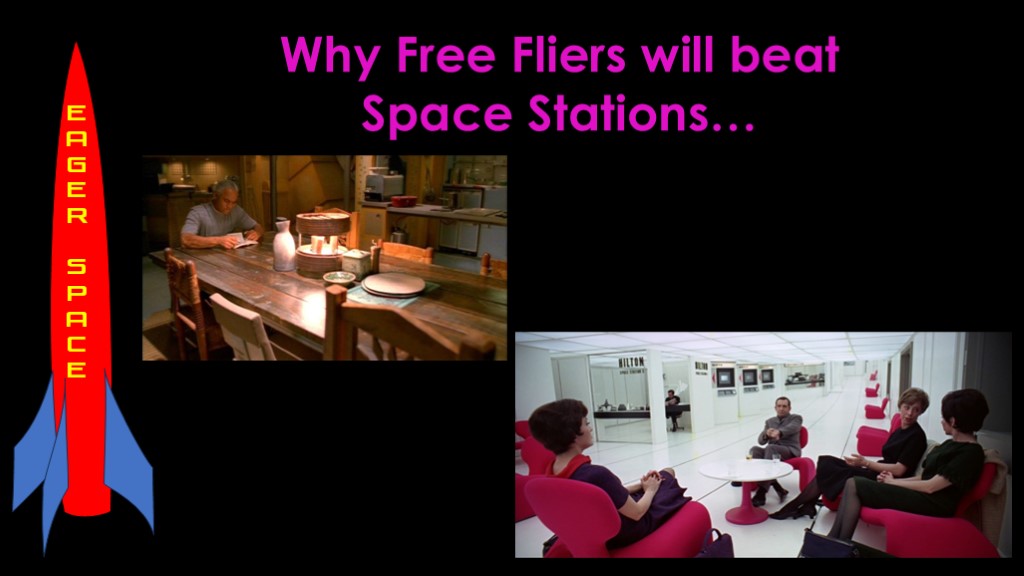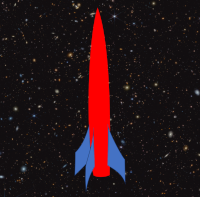
 |
Eager Space | Videos by Alpha | Videos by Date | All Video Text | Support | Community | About |
|---|

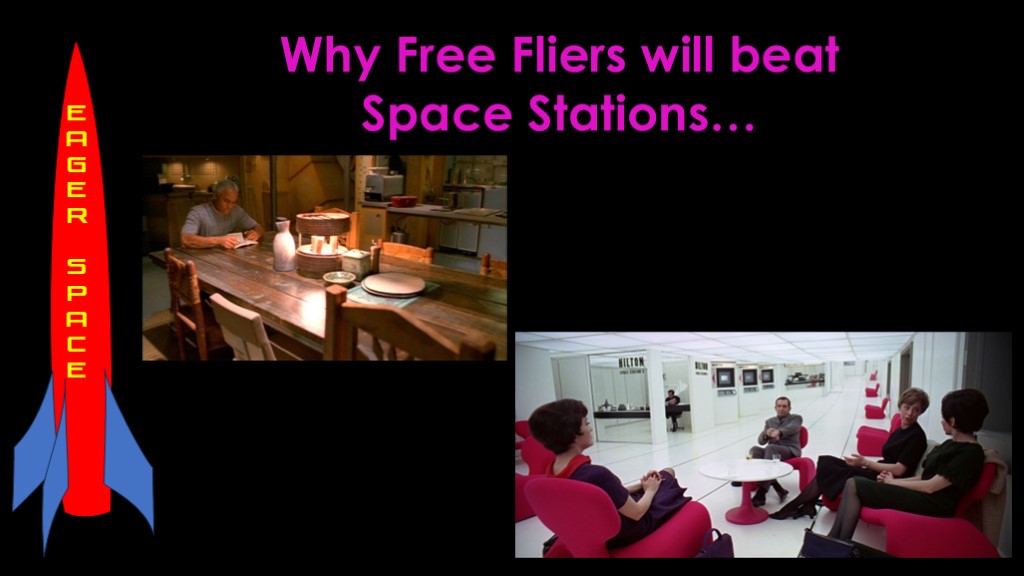
Acceleration environment of the ISS
https://www.nasa.gov/wp-content/uploads/2016/06/acceleration-environment-iss-mini-book_detail-508c.pdf
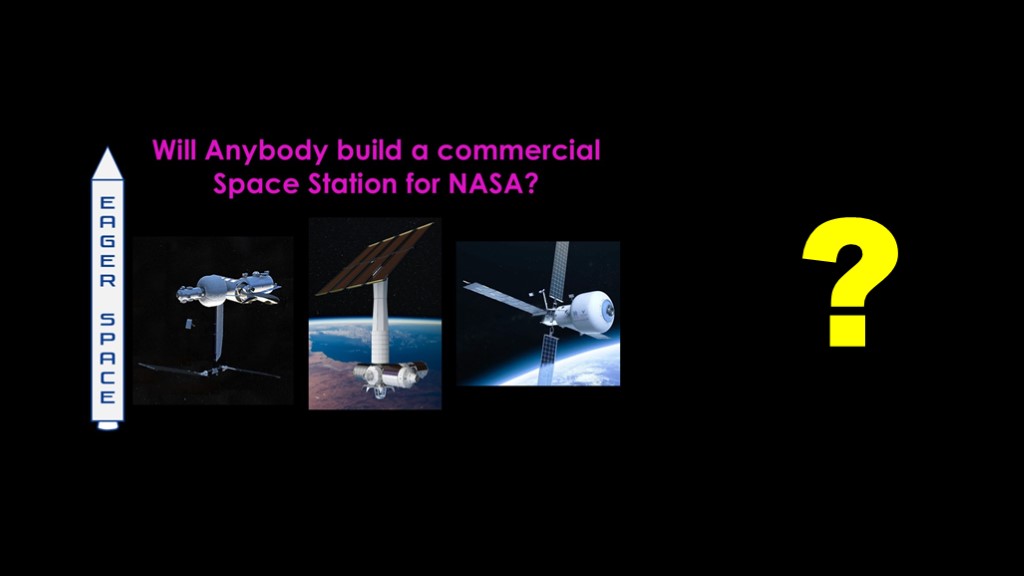
Last September I did a video on commercial space stations, and my conclusion was that it's very difficult to make a good business case for space stations. And by that I mean that I don't see why anybody would want to invest in one.
If space stations aren't the answer, then what is?
I had a possible answer to that question at the time, but it's taken me 9 months to get around to doing a video on it.

For our discussion, it's useful to have a space station in mind, and I've chosen Haven 1, the space station that Vast Space is working towards, but this argument applies to commercial space stations in general.
The crux of the issue is the financial model.
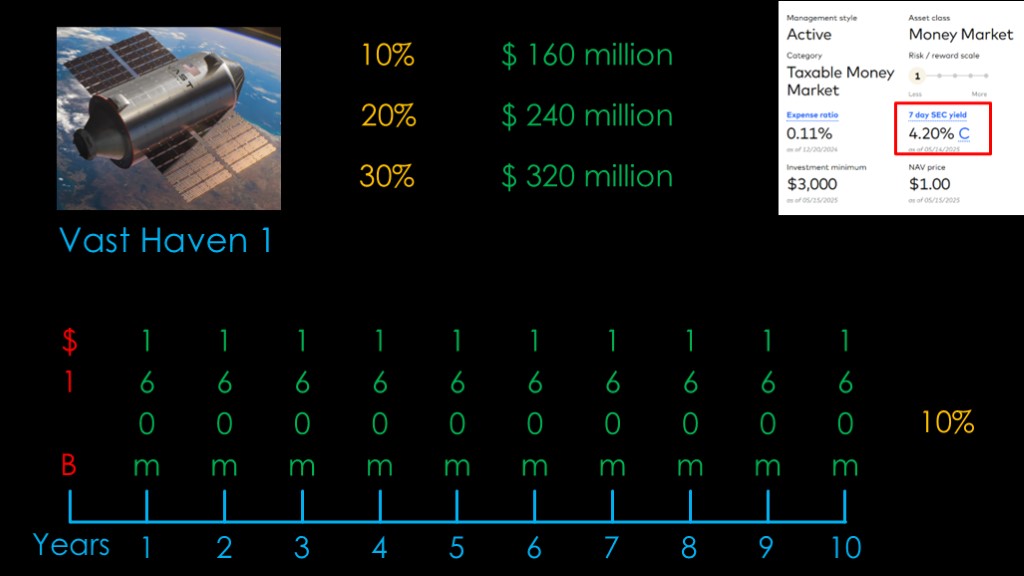
To make the investment worthwhile, investors need to get more money out than they put in. Remember that this is a privately funded station - there's no NASA money paying to develop it.
It will cost Vast in the neighborhood of 1 billion dollars to design, build, test, and launch their first space station. I'm going to pretend that they did that all in a year to make the analysis simpler. If they launch and then managed to generate 160 million of free cash every year for the next 10 years, that money can go to pay off their investors. That specific amount of free cash will generate a 10% return.
That's not very exciting. I can get over 4% on my money by just putting it into a money market cash fund with minimal risk, and there are many relatively safe investments that will generate a 10% return. Investors demand a higher rate of return for riskier investments.
If the investors want 20%, that's $240 million every year, and if they want 30%, that's $320 million every year.
I'm going to be using 20% as a moderate level. If you are taking venture capital money, they are going to be looking for higher rates. VC funds expect that half of their investments will fail, so the ones that hit need to generate very good returns.
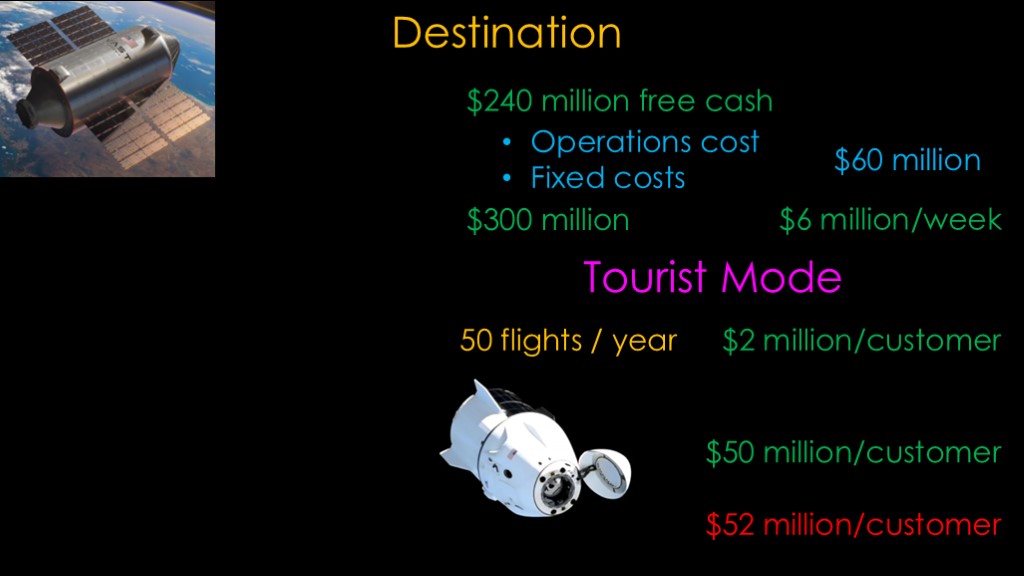
We now need to figure out how we can get $240 million per year.
Except it's not actually $240 million. We need to pay for our operations costs to keep the station up and running and to pay the fixed costs to keep the company operating. I'm going to add $60 million for that; it could be much more.
That means we're looking for $300 million every year, or about $6 million per week.
Let's look at the tourist side of things first.
If we can populate 50 flights on crew dragon each year with three passengers and one employee per flight, we only have to charge $2 million per customer. Are there 150 people who would pay $2 million to spend a week in space. Hmm. Maybe.
Unfortunately, we need a way to get them there. If we can convince SpaceX to fly crew dragon that often, maybe they'll do it for $150 million a flight, or $50 million per customer. That pushes the cost up to $52 million for a customer to come visit for a week.
Right now the transportation costs just kill you; there aren't 150 people who will pay $52 million to spend a week in space, much less 150 people every year for ten years.
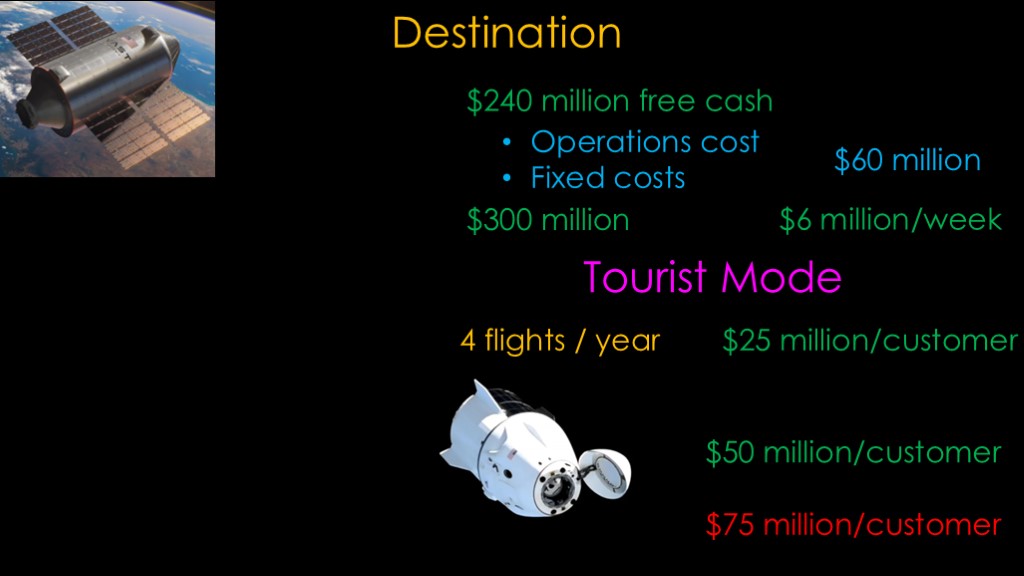
What if you only fly 4 times a years. That bumps the per-customer price up to $75 million, and you only need to find 12 people a year, or 120 people over all. That seems like a big ask, and you need to do it year after year.
There just isn't a tourist market right now.
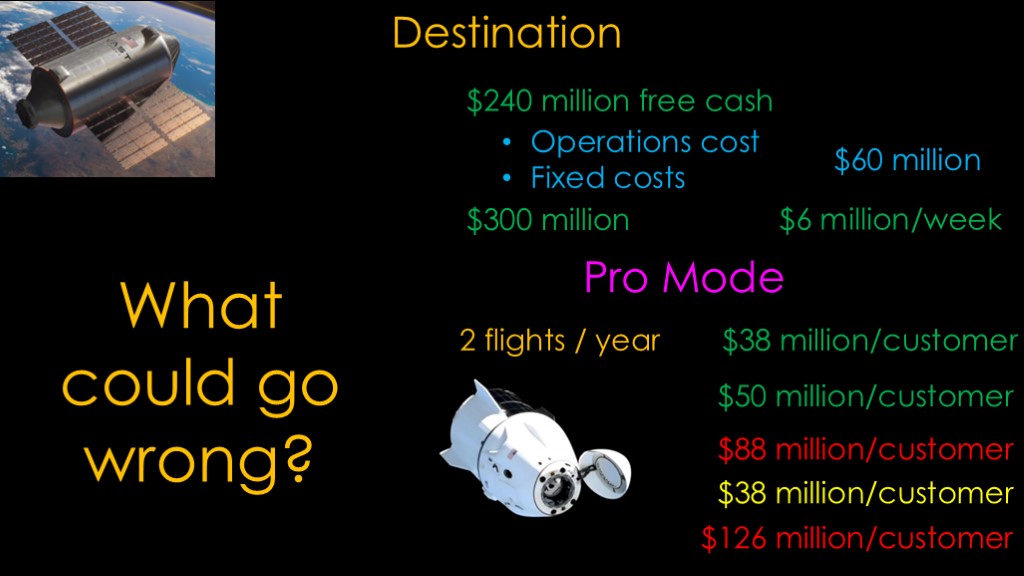
What if we can get NASA and other countries as customers?
Let's assume that you are going to do two flights a year following the ISS model of 6 month missions, and let's also assume that our customers are all trained astronauts so we don't need an employee to go with them. We need to get $38 million from each customer and if SpaceX will fly us for $200 million, that's another $50 million per customer, for a total of $88 million/customer.
But dragon doesn't carry enough to keep a crew supplied for 6 months, so we'll need one resupply flight, which is another $38 million for $126 million total per customer.
And you can play around with the numbers here - Maybe you do one 1 months flight and one six month flights and you can do a month without resupply.
Those numbers kindof work. If you can get NASA and other countries to pay for those 8 astronauts per year, you can generate enough cash flow.
What could go wrong?
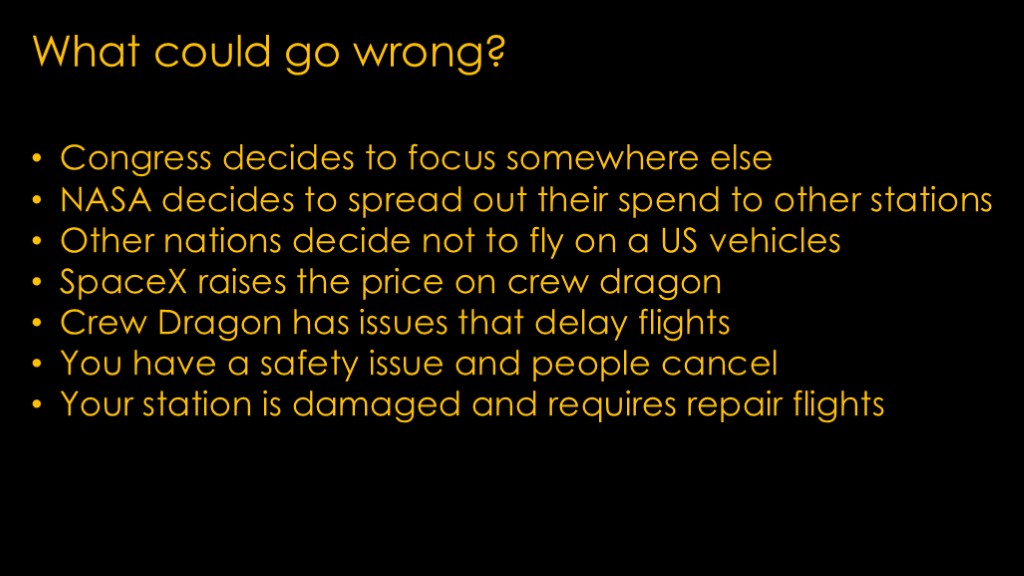
This list only took me 10 minutes to come up with.
(read)
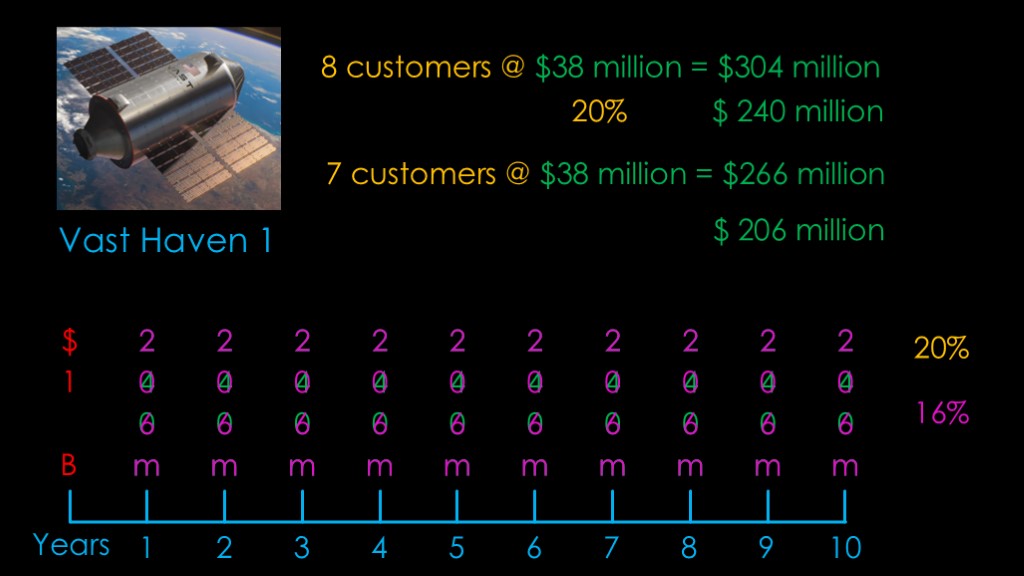
Let's look at a simple shortfall.
We are a little off on our market estimates, and we can't fill one of the 8 seats each year.
Instead of $240 million after other expenses, we only get $206 million. That's an 12% reduction in business, but it knocks our rate of return down nearly 25%, all the way down to 16%. If we have to cancel or delay flights, it's much worse.
In summary, we need to operate at capacity to get the cash we want and there are a number of issues beyond our control that could reduce our revenue to various degrees. If we want to get more business in the future, we need to solve the transportation cost model but that's not under our control.
This isn't the kind of business I would want to invest in.

It feels like space stations are this very cool business at the cutting edge of tech.
But your cost structure is much more like a very exclusive luxury resort and your market is unknown.
But perhaps not that unknown. What do we know about the market?
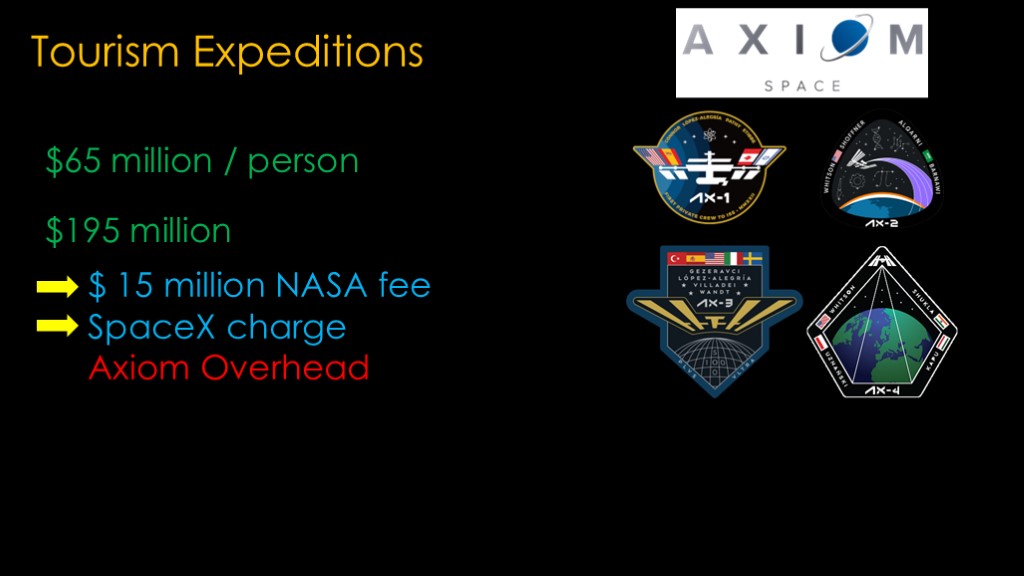
Axiom has an agreement with NASA to fly to ISS for short visits, on what I call "tourist expeditions". They have flown 3 missions and are getting ready to fly a 4th.
Their price in 2024 is about $65 million per person, with 3 passengers and one Axiom astronaut on each flight. That gives a total flight revenue of about $195 million.
When they fly, they will need to pay approximately $15 million to NASA, whatever SpaceX charges for the flight, and their own overhead for running the program.
The important part of their business model is that the two biggest charges - the NASA fee and the SpaceX charge - only show up when they are actually flying a mission. The only thing they have to pay whether they fly or not is their overhead.
If you can buy access to the biggest space station ever, you don't have the big investments up front. Assuming Axiom can keep their overhead low, they can make sure that they make money on this program even if they are only flying about once every year.
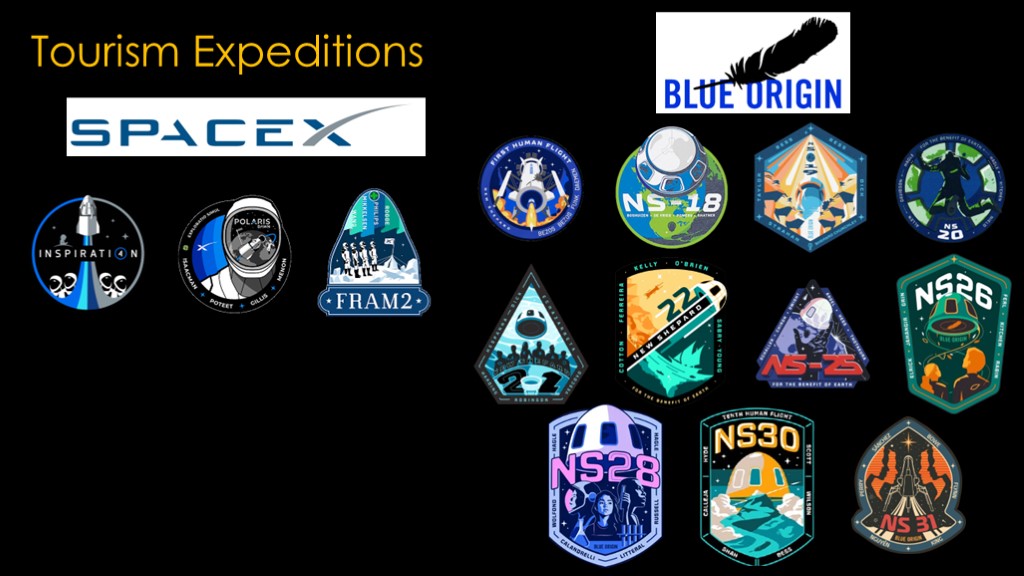
If you don't have access to a space station for cheap, you can just fly missions whenever somebody is interested. That's the SpaceX model with Inspiration 4, Polaris Dawn, and Fram 2.
This has the same model; SpaceX doesn't have to pay off crew dragon development because NASA paid them to build it, and they can fly whenever it makes sense. This is a great business model.
Blue Origin is a little different - they *did* pay to develop New Shepard, but all 11 New Shepard crewed flights followed the expedition model.
That's 18 crewed missions that somebody has paid for, and all of them follow the expedition model where there is no fixed asset owned and operated by the company.
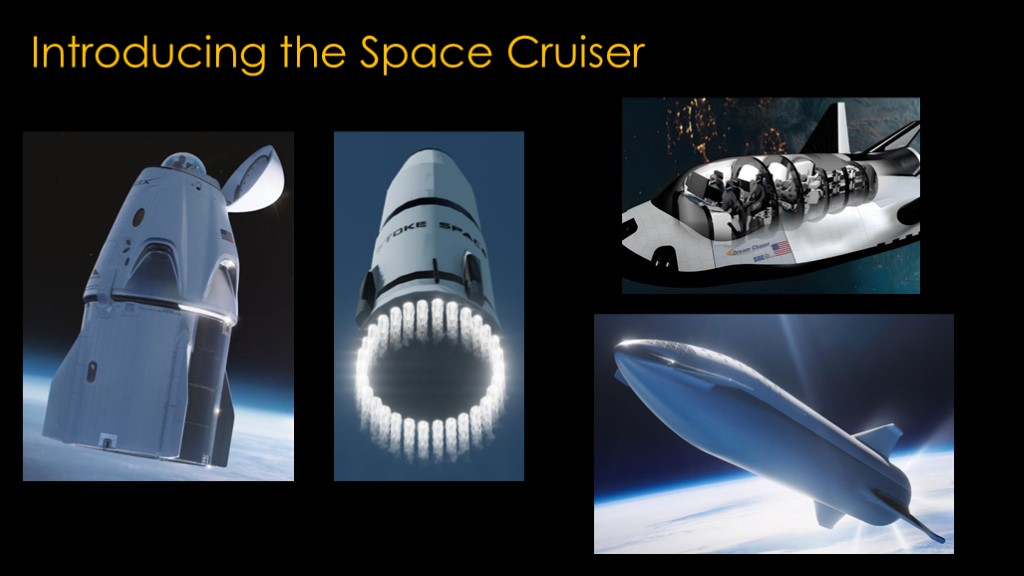
Currently the only orbital crew game in town is crew dragon, and it's quite expensive.
But you could maybe take Stoke Spaces reusable second stage, starship's second stage, and perhaps Dream Chaser's cargo version and modify them to support space expeditions.
You will need to pay for the mods, but it's going to be cheaper than a space station and it only has operational costs when you are flying the thing. Fly it however often to meet the demands.

This the cruise ship model. You can start with a small boat, doing short excursions. Figure out what the market is like, then adapt. Go larger, and work your way up to small multi-day excursions.
And then maybe, over time, you can go big.
There are countless small businesses out there following the same model, though probably not many where each transaction might cost $50 million.

Free flying space cruisers are a better model for tourism. But what about the other things that a space station can do?
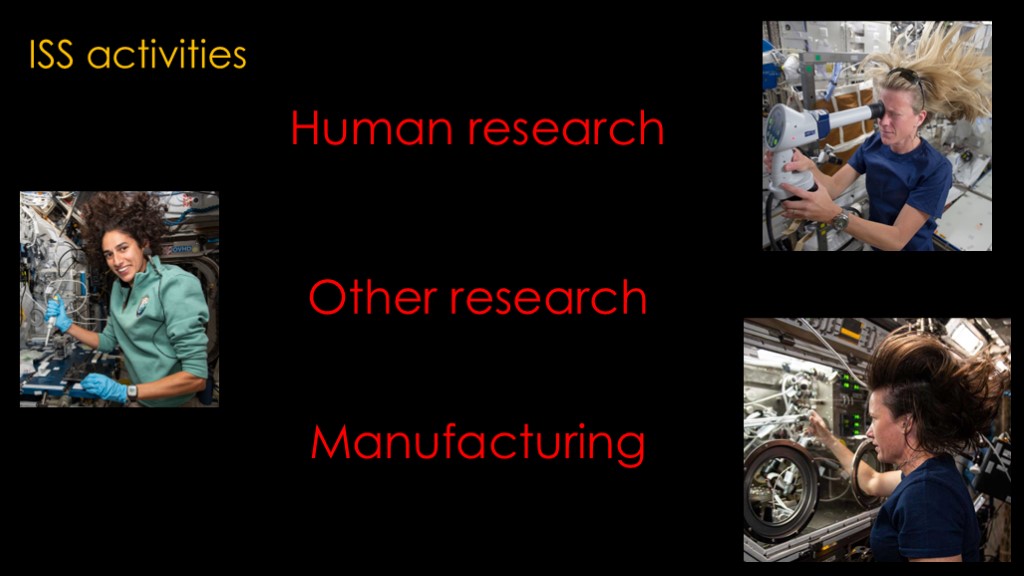
There are three sorts of activities on ISS
There is Human research, doing experiments to better understand how human are affected by the orbital environment.
There is other research, some of it general research, some of it aimed at specific commercial applications.
There is manufacturing, which really hasn't happened on the ISS.

Human research has been a cornerstone of orbital research since the days of Skylab and NASA has heavily invested in it.
It's certainly important to understand how the human body is impacted by spaceflight, especially for longer missions. But after 25 years of ISS expeditions, we have an extensive database of medical data and have reached the point of diminishing returns.
Most of the current attention is on the moon and mars, and you'll probably want to focus research on what happens in those gravity environments.
If you want to do more human microgravity research, you do need a spacecraft that can house humans for a longer mission.
That might be a space station, but it could also be a Starship variant that has enough supplies for a 6 month mission. Or maybe a couple vehicles in a configuration that provides lunar or martian gravity environments.

And what about microgravity research and manufacturing?
It turns out the crewed space stations are not a great fit because they are not calm places.
It's enough of an issue that NASA produces a 50 page overview of what the acceleration environment in ISS is like.
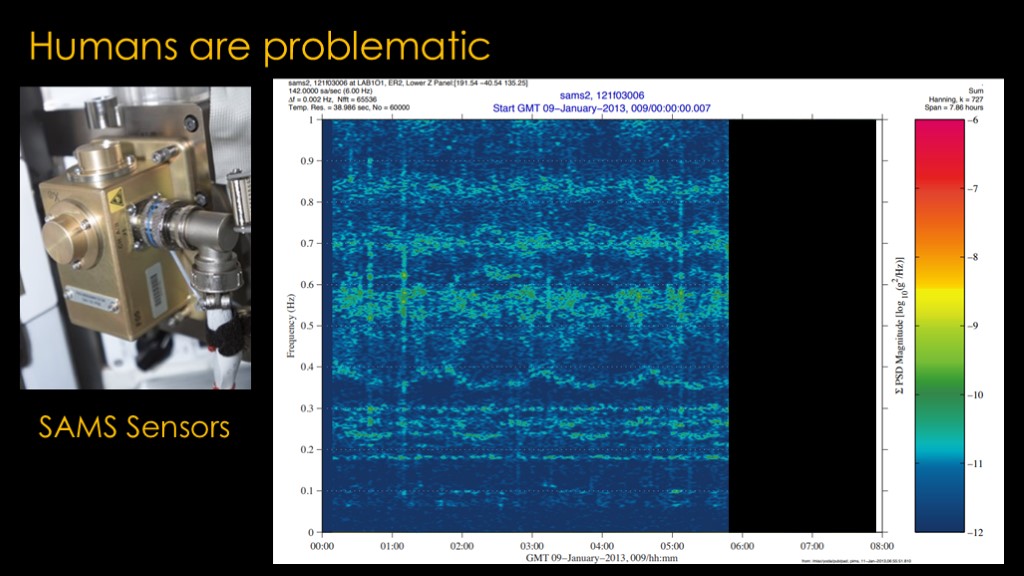
It's mostly about the humans.
The ISS has five SAMS sensors that collect data on how the space station vibrates. This is a plot from the 9th of January in 2013.
The vertical scale is the frequency of the vibration, from 0 to 1 hertz. Humans can hear sound down to about 20 hertz, so this is much lower frequency than that.
The horizontal scale is time. The colors are a logarithmic scale, so the light blue we see in this plot is about 10 times the intensity of the dark blue.
This acceleration during this period here is very low - on the order of millionths of earth gravity, or micro gs.
And then the humans wake up. Just having them awake increases the vibration environment by 10 times, and those little red dots are over 3 orders of magnitude -1000 times - the vibration environment when they are asleep.
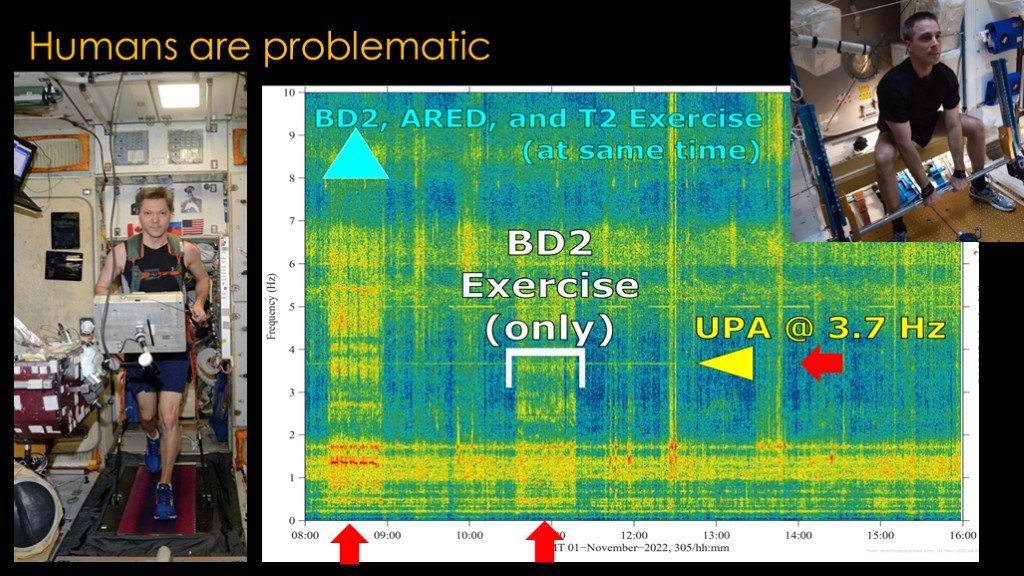
Here's another plot, showing vibration at a higher frequencies during crew exercise.
We can see a large increase when an astronaut is on the BD2 treadmill.
On the left side, astronauts are exercising on the BD2 treadmill, the second T2 treadmill in a different module, and the ARED resistance training device.
Astronauts need to exercise often to prevent the loss of muscle and bone mass, but it doesn't do good things for the microgravity environment.
The UPA line at 3.7 hertz is also because of the astronauts, though indirectly. The ISS processes astronaut urine to produce drinking water (I've always said that astronauts are extremely good sports) so that less water is required, and the urine processing equipment vibrates at this very specific frequency when running. There is other life support equipment that may also be an issue - note the dashed line at 5 hertz.
And we also have other red speckles all over the place. Those will be caused by various things, including astronauts pushing off on the walls to move around the station.
What this means is that you can do decent microgravity research at night, but the environment isn't great during the day and there are both expected and random vibrations. Not great if you want to run a process that takes a week.

Astronauts and cosmonauts get cranky if you don't feed them and bring them new clothes because there are no laundry facilities on the ISS, and that means that you need regular supplies.

That means that you need a visit by the Russian progress or the US cargo dragon or cygnus spacecraft.
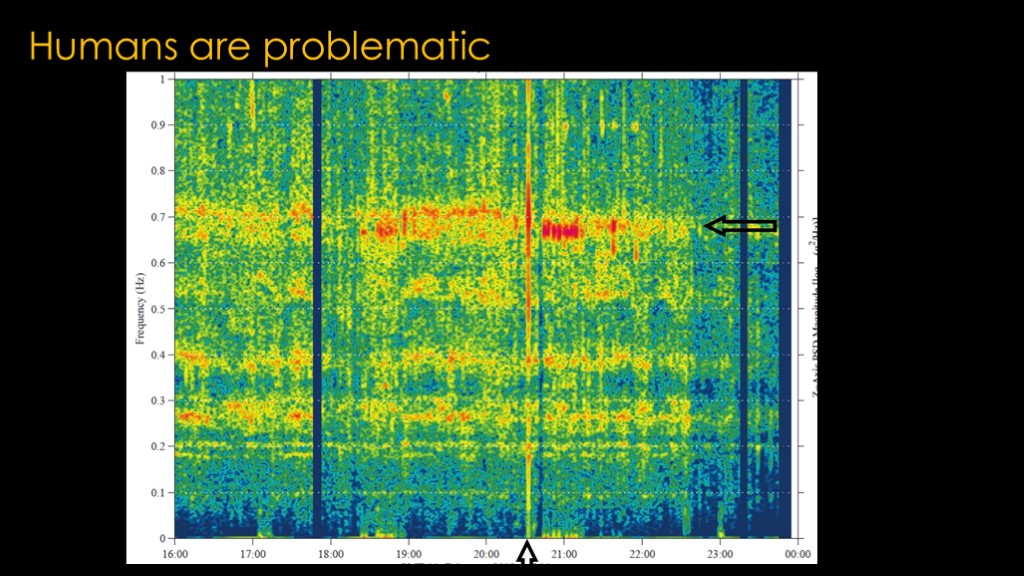
This is a progress arriving at the station. You can probably figure out the time when it docked without the arrow at the bottom.
Perhaps more interesting is that the docking put enough energy into the station overall that it started "ringing" at about 0.7 Hz for about 2 hours. That's what the second arrow on the right is pointing to.
Dragon 2 docking is likely similar. Cygnus will be less because it doesn't dock, it is grappled by the robotic arm and installed on the station.
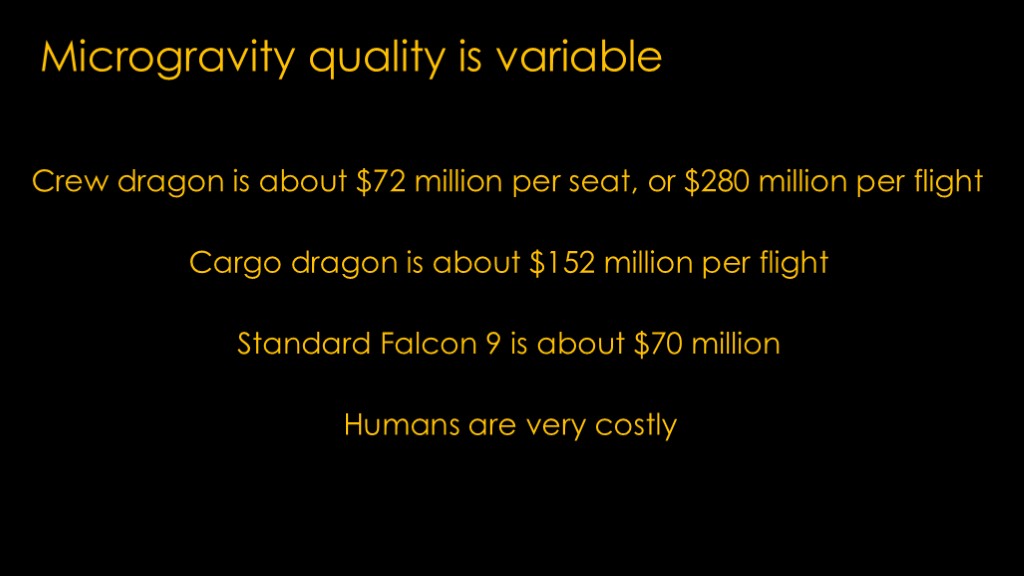
All of this means that the quality of microgravity on a crewed station is variable. If the only equipment operating is the life support system and its well-designed and functioning properly, there aren't many issues when the crew is asleep.
When the crew is awake, there can be issues and those are hard to predict. Not really the ideal environment.
Worse, your transportation costs are very expensive because you need them to be rated to work around the station safely because the station is a huge investment. Crew dragon to ISS costs NASA about $280 million per flight, cargo dragon costs about $152 million per flight, and a standard Falcon 9 launch is $70 million
(do a graph here).
And your station is more expensive because it has to support humans.
We could hypothesize that maybe somebody could create a free flyer dedicated to research and manufacturing, one that doesn't carry crew.
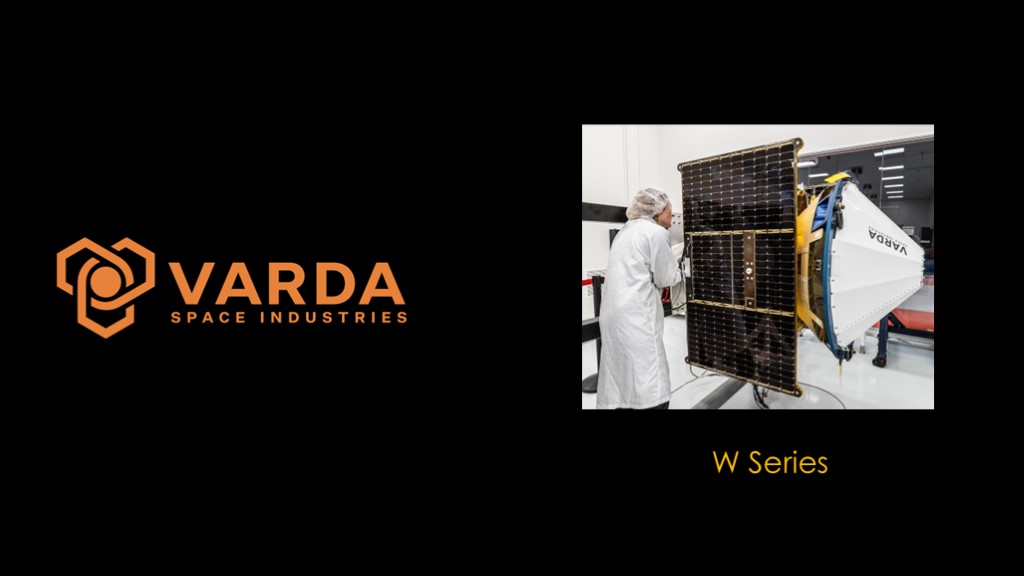
Luckily, such a vehicle already exists, and it is the W series vehicle from Varda space industries.

Let's compare the Varda approach to the Vast approach...
Varda's vehicle is a free flyer, and Vast's is a space station. The payload for Varda is currently only 120 kg as it is a small spacecraft that flies on Falcon 9 rideshare programs. Payloads would get to Haven-1 on either a crew or cargo mission, presumably flown on a dragon. The payload size would be limited by the constraints of those missions.
Varda will offer a nearly perfect microgravity environment; the spacecraft will be able to remain nearly inert with the only requirement to maintain orientation of the solar panels to the sun. Haven-1 will have a similar environment to ISS.
The mission length for the W series free flyer is dependent on the customers; it might be a short period or it might be a longer mission. It is currently constrained by the rate of SpaceX rideshare missions, which is about 3 times per year. Payloads to Haven need to go up on one mission and then come down on a future mission.
Varda is following the expedition model, which you already know I like. They have started very small, buying only part of a SpaceX Falcon 9, and are already flying paying customers, with payloads for the US department of defense and NASA.
Vast is following the destination model, they "if you build it they will come" approach.
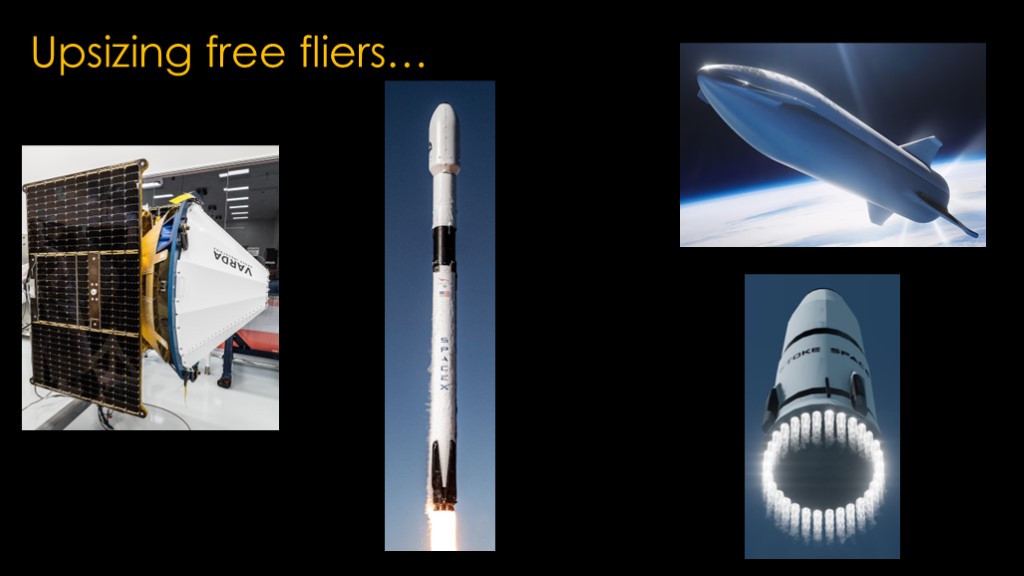
If the market is there, free fliers can be upsized to occupy an entire Falcon 9.
But the more fascinating approach is for vehicles with a reusable second stage. Take a stoke space second stage or a starship, pay to have it customized for whatever you want to do with it, and then launch it over and over to do that specific thing.
When you aren't flying it, it's just sitting in cheap storage someplace near the launch site. And you can easily modify it and upgrade it because it isn't in orbit.
